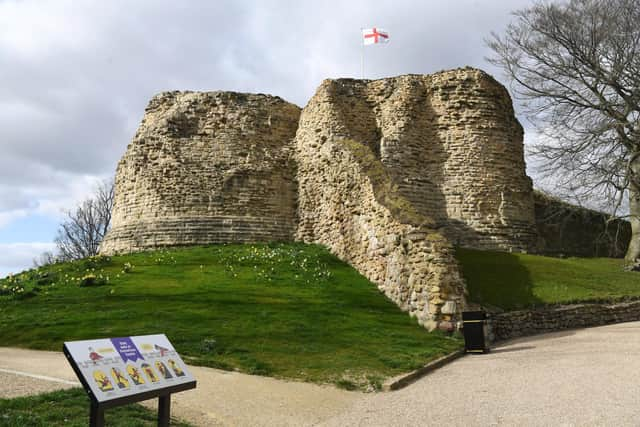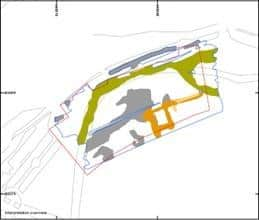Remains of 15th-century chapel discovered beneath Pontefract Castle - and mystery of lost dungeon could be solved
Site managers Wakefield Council and Wessex Archaeology carried out the study with ground penetrating radar, initially to locate service buildings between what would have been the castle’s kitchens and royal apartments, but made a far more exciting discovery.
They instead found the remains of a tower that can be seen in drawings made during the Elizabethan era by Ambrose Cave in 1561. However, these plans gave the impression that the chapel was located further inside the castle bailey instead of beside the curtain wall.
Advertisement
Hide AdAdvertisement
Hide AdPrevious geophysical surveys of the area revealed very little, but it was the ability of the ground penetrating radar to reach greater depths that allowed the find to be recorded. It is thought that later Victorian landscaping and the cultivation of liquorice plants raised the ground surface, hiding any underlying archaeology.


It is believed the chapel was a private one attached to the royal apartments.
Last month, a man who visited Pontefract Castle as a teenager in the 1960s raised the possibility that an ‘oubliette’ – underground dungeon – had been blocked up and possibly forgotten about since. John Atkinson has called for a survey to be undertaken of the bailey, as both he and other witnesses claimed to have been inside the oubliette, which was accessed via a trapdoor and distinct from other underground workings, on a guided tour. He recalled seeing the trapdoor, albeit locked, in the 1980s, but it has since disappeared and the area grassed over.
Both Wakefield Council and Historic England dismissed the existence of the cell, but landowners the Duchy of Lancaster have expressed interest in commissioning their own ground survey next spring using improved technology.
Advertisement
Hide AdAdvertisement
Hide AdA member of the Duchy’s staff visited the site after being contacted by Mr Atkinson, and himself remembered seeing the oubliette as a child and that it was separate to a later dungeon that has also been open to the public.


The Duchy did not wish to comment at this stage.
Castle Studies Trust chair of trustees Jeremy Cunnington said: "The Castle Studies Trust is delighted to have funded this survey. By finding this 15th-century chapel we have advanced the understanding of this important royal fortress by finding this lost chapel and further building on the extensive research carried out on the castle by Wakefield Council over the last decade.”
History of Pontefract Castle
Pontefract Castle is one of the most strategically important fortresses in English history. There was a wooden castle on the site after the Norman Conquest in 1070, built by the de Lacy family, who remained there until the 14th century and rebuilt it in stone.
During its life the castle fulfilled different functions; acting as a fortress, a royal castle, a centre of local administration, a prison and an armoury. One of the most infamous uses of the castle was to imprison King Richard II who eventually died of starvation there.
Advertisement
Hide AdAdvertisement
Hide AdIt is the vanished oubliette where John Atkinson believes the king was incarcerated after his capture; the 1960s tours of the castle included this information.
At this time the castle was passed into the ownership of the House of Lancaster, but it was here that Thomas, Earl of Lancaster was beheaded just after his defeat at the Battle of Boroughbridge.
It was the location of royal scandals including the adultery of Queen Catherine Howard, the fifth wife of Henry VIII, whom it is alleged was caught with Sir Thomas Culpeper there. For this crime she was beheaded without trial.
Pontefract Castle also played a major role in the English Civil War, acting as one of the last Royalist strongholds. It was during this period that the castle suffered ruin and dilapidation until it was finally demolished in 1649.
